Recommend
Overview Copied
Using baseline analysis, Capacity Planner provides automatic recommendations for improvements in the configuration of machines or instances currently active in your IT estate.
Depending on the type of environment you are running, this includes right-sizing recommendations, target vCPU configurations, hardware deployment in clusters, or storage reduction. The recommendations are fully configurable allowing you to set up activity threshold settings and minimum configuration for right-sizing.
All these recommendations can help you reduce the cost of maintaining your IT estate by recommending cloud migration, and if you are already using AWS or Azure, you will see further recommendations that will help you optimise your cloud cost. Recommendations are made based on machines or instances that are currently running, based on the last data collection.
In the Recommend panel, you can:
- View default recommendations for server activity and storage.
- Check estimated costs of cloud migration.
- Check how you can optimise your instances or virtual machines.
- See which EC2 saving plan would be most optimal for you (if you are using an AWS environment).
- View the list of hosts and workloads that are breaching thresholds.
Depending on what type of environment you are using, the Recommend panel displays different options:
Recommendations for cloud environments Copied
This section describes the features available in the Recommend panel if you are using a cloud environment, either AWS or Azure. If you are using an non-cloud environment, see Recommendations for non-cloud environments Recommendations for non-cloud environments.
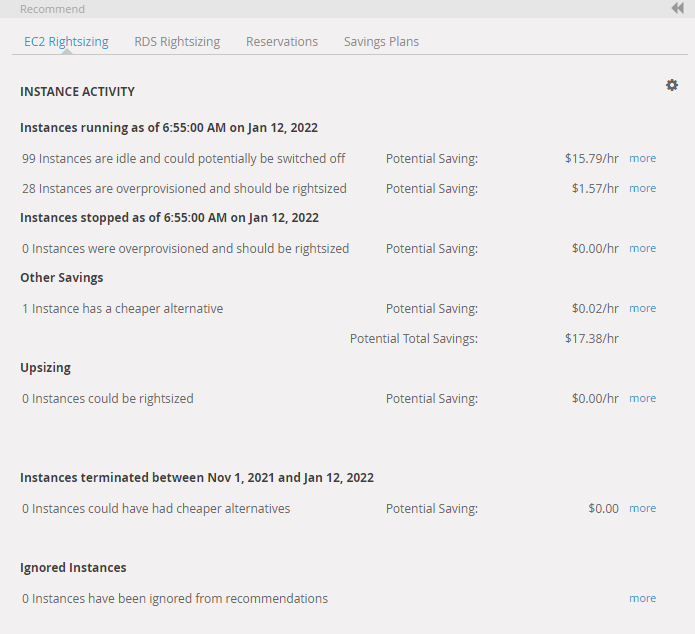
Instance or virtual machine activity Copied
In the Rightsizing tabs of the panel, you can find the EC2 instance, RDS machine or Azure virtual machine activity recommendations for instances and machines depending on their activity:
- Idle
- Underprovisioned — machines with high activity
- Overprovisioned — machines with low activity
- Normal — machines that fall into the normal category are displayed as Other savings. This means that these can be changed to a cheaper alternative but still have the capacity that it needs.
- High — recommendations for machines that are very busy are categorised as Upsizing. Upsizing can be a potential cost and not a saving.
Calculations of your potential savings are based on these recommendations. By default, savings are displayed in dollars per hour. Click the Potential Saving number and the calculation will change to dollars per day/week/month/year.

To see the full list of Recommendations, click More. This displays the list of all instances or virtual machines with detailed recommendations on the changes that you can make in order to reduce the cost of running them.
To filter your view further, you can use the Grouping columns. For example, you can use Cloud Service grouping to differentiate between instances or machines that make use of various cloud services. For more information on how to use groupings, see Groupings manager.
To see more detailed data that is used by Capacity Planner to arrive at the recommendations, you can go to Instance options.
To remove some machines from recommendations, you can add them to the list of Ignored instances Ignored instances.
All recommendations are based on the way activity rules, optimization settings, and right-sizing rules are configured. Every time you make changes to those settings, the recommendations are updated. For more information, see Configure cloud recommendations.
Note
When you make changes to your sunburst or timeburst view, or you look into more detail, recommendations are dynamically updated to display information relevant to your current view.
Instance options Copied
To see detailed recommendations for a specific instance, click Options ![]() next to the instance or virtual machine that you wish to see details of, and select Recommendations.
next to the instance or virtual machine that you wish to see details of, and select Recommendations.

In this window, you can see the detailed data that is used by Capacity Planner to arrive at the recommendations that you are given.
You are presented with a horizontal radar chart where each vertical line represents a metric that is used in the calculation of the optimum instance. Based on right-sizing rules and Optimization settings, Capacity Planner determines the best and cheapest fit for that particular instance. It gives you a number of options to move your instances so that you can compare the prices and select the best fit.
Since in RDS you get memory statistics by default, this is also included in the chart making right-sizing more accurate because of memory utilisation.
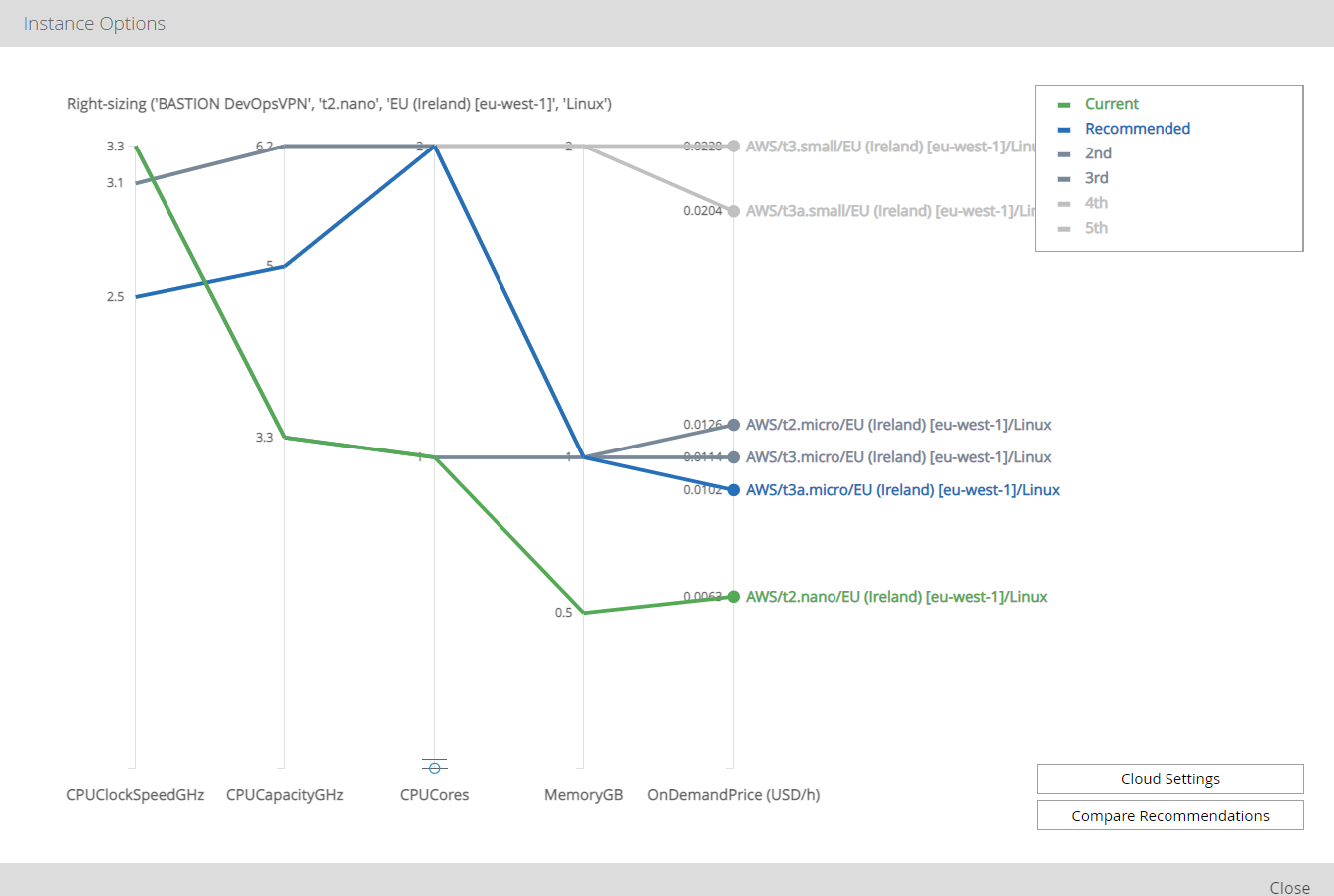
You can click OnDemandPrice to switch between all available reserved price options for the highlighted recommendation.

Click Compare Recommendations to see this graph presented in a table form to compare all the recommendations and see their details.
You can also temporarily overwrite some of the specific options that you configured in Optimization settings. To do it, click Cloud Settings. Here, you have access to all the right-sizing capabilities which you can change in order to tailor your instance more.
For example, if the Region of your instance is Asia but in Optimization settings you selected All regions to be used when calculating your recommendations, this will be ignored, and only your current region (Asia) will be taken into consideration. You may want to use this option if the cheapest recommendation suggests moving your instances to a different region but you want to check the cost of staying in your current region.
You can set the value for memory and CPU utilisation while interactively right-sizing and right-buying. The current chosen statistical measure can be overridden and, if there is no data available for a metric, a default value can be chosen. This way, you can use override value regardless of what has been set up for this measure.
If there is no data about memory usage then it is difficult to right-size memory. But if you have knowledge about memory performance, you can change the settings in such a way that memory is taken into consideration in recommendations. Ticking the Override percentile selection check-box lets you use the new value regardless of whether or not there is data for this metric.

Note
Changes that you make in the Cloud Settings do not permanently overwrite the optimization settings that you set up. They are only applied to the one instance that you are currently viewing and are discarded when you close the window.
Configure cloud recommendations Copied
To configure rules for cloud recommendations, click ![]() in the Default Recommendations tab, and select one of the options:
in the Default Recommendations tab, and select one of the options:
- Optimization settings Optimization settings
- Configure activity rules Configure activity rules
Note
Recommendations are only based on instances that are currently active. If an instance is switched off, it is not taken into consideration in the recommendations.
Optimization settings Copied
You can configure specific AWS or Azure settings based on which recommendations will be made.
You can select a region (each region has different pricing), instance family, network performance, or storage class. For more information on these settings and how these can affect your system setup, please refer to AWS official documentation or Azure official documentation depending on your provider.
For example, if you only select EU regions as your location, Capacity Planner will look for optimum configuration in those regions only.
For Amazon RDS, you can select a specific Database Engine and License Model.
These settings can be overwritten when you are viewing detailed recommendations of a specific instance. For more information, see Instance options.
You can exclude idle machines from your recommendation rules.
You can also configure right-sizing rules. For more information on available measures, see Select measures in Right-sizing. Note that only right-sizing options applicable to cloud environments are available.
Configure activity rules Copied
You can configure activity thresholds to fit an appropriate recommendation. Server activity is defined by the activity grouping. For more information, see Activity grouping.
When you change your configuration, the recommendations are automatically updated. Any machine or instance exceeding your configured activity thresholds can be assigned the following recommendations:
- Idle — machines or instances that meet these criteria are listed as idle and are recommended to be switched off.
- Low — machines or instances that meet these criteria are listed as overprovisioned and are recommended to be right-sized.
- High — machines or instances that meet these criteria are listed as underprovisioned and are recommended to be right-sized.
- All other machines or instances are considered normal.
You can restore these settings at any point by clicking Reset.
In the example below, machines or instances that are considered as idle fall within the following criteria:
- CPU 95th percentile is less than 5, and
- IO is less than 20 MB/s, and
- Memory 99th percentile is less than 10.
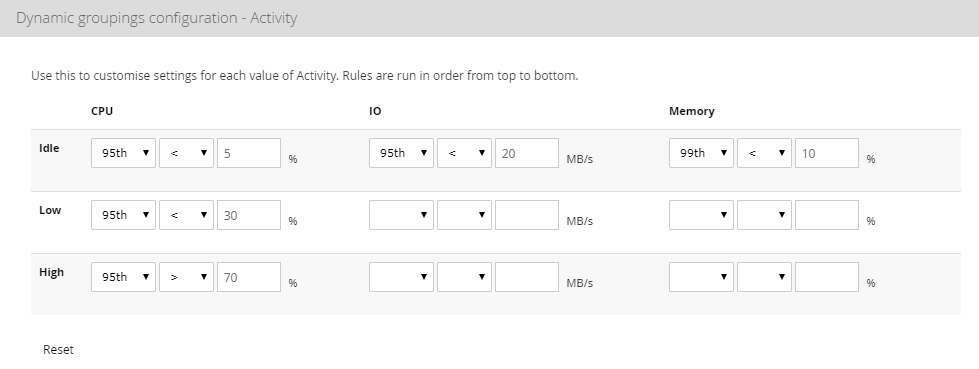
Potential savings on terminated instances Copied
Instances that are no longer running are not taken into account when calculating saving costs. The Instances terminated between [dates] allows you to get an idea of how much your organization could have saved if the recommendations had been applied on these instances before they were switched off.
Savings Plans Copied
Savings Plans is one of Amazon’s recommended ways of saving money on compute costs. The Savings Plans tab shows what you could save if you committed to a particular spend. Capacity Planner applies discounts to the setup that you currently have and shows you what you could be saving. You can check your potential average saving per hour with the cost of the savings plan. It determines if you should decrease your savings plan to save more or increase it and thus save more.
Savings Plans recommendations take into consideration existing Reservation purchases before providing an optimised hourly rate across all accounts for AWS compute savings plans.
You can also right-click on any grouping in the sunburst or timeburst and auto-generate an optimised savings plan value for that collection of instances.
To see more details of each recommendation, click more. Here, you can see and analyse in more detail how much money could be saved based on the selected model.
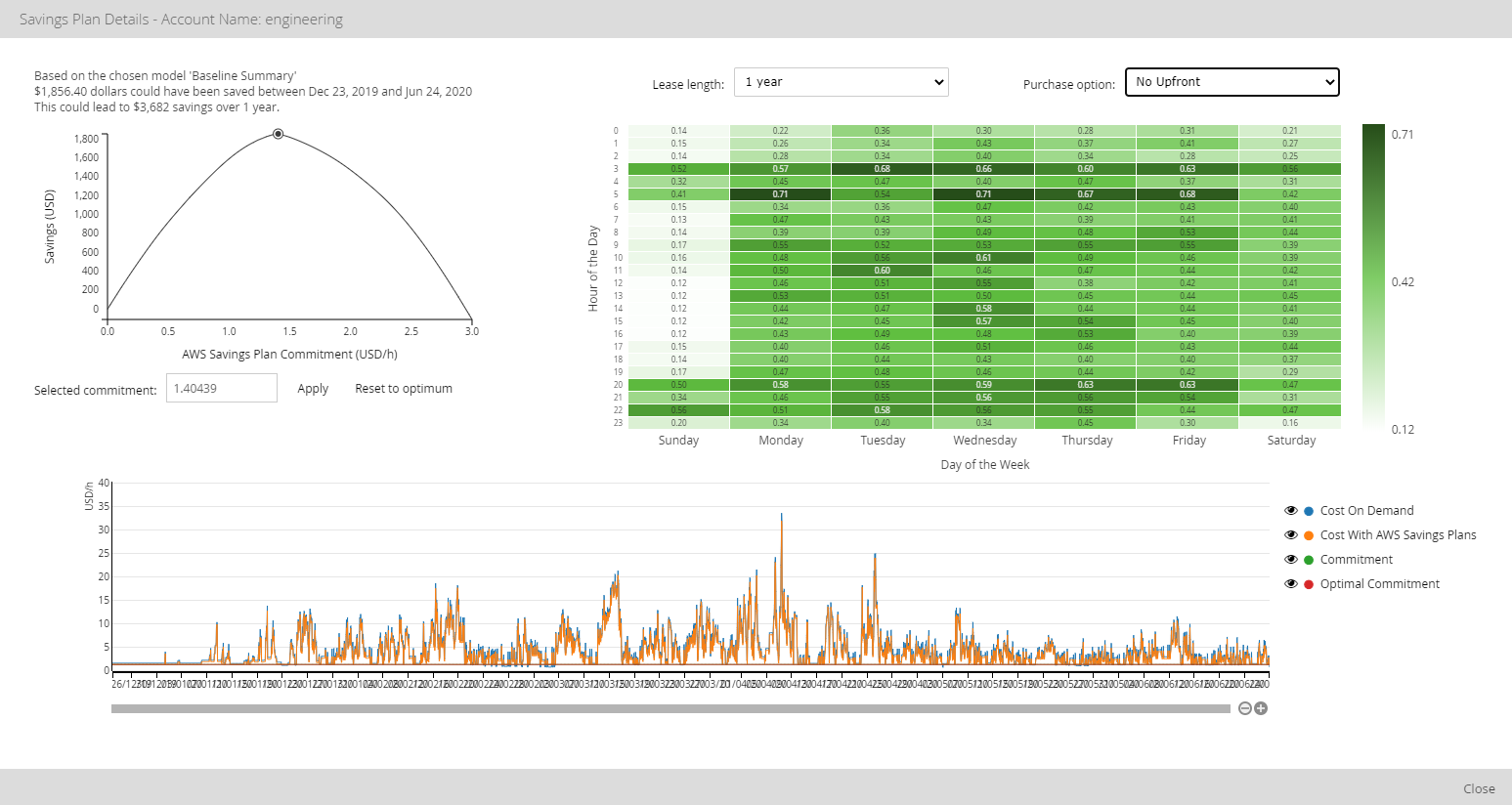
- The graph on the left displays the optimum savings curve. This is the level of savings you would make depending on your commitment and your purchase option. Based on this curve, the optimum saving is calculated.
- The table on the right shows your potential savings on average. It allows you to see when on average savings are being made and when losses would be made.
- On the bottom:
- Cost on demand — current cost on demand that the organisation has been paying in the time specified in the model.
- Optimal commitment — this is our recommendation. Anything above the red line is a saving, anything below is a loss.
For more information on Saving Plans, see Amazon Savings Plans documentation .
Note that when you add or remove instances from the ignore list, needs to recalculate Saving Plans. In the Saving Plans tab, click the refresh button to recalculate.
Ignored instances Copied
You may have a number of machines that need to be configured in a certain way at all times even if they are not using a lot of resources. These machines always need to be of a certain size and you will never want to change it.
You can add a machine or group of machines to the list of ignored instances. These machines will then be ignored by any recommendations.
To add an instance to the ignored list, do one of the following:
- In the Default recommendations tab, click More to open the full list of Recommendations. Select the machines you wish to ignore and click Add selected to ignore list below the table.
 '
' - In the Sunburst view, right-click the required segment, select Workloads, and click Add to ignore list.
- If you click directly on a workload, only that one machine will be added to the ignore list.
- If you click on a cluster, all machines will be added.
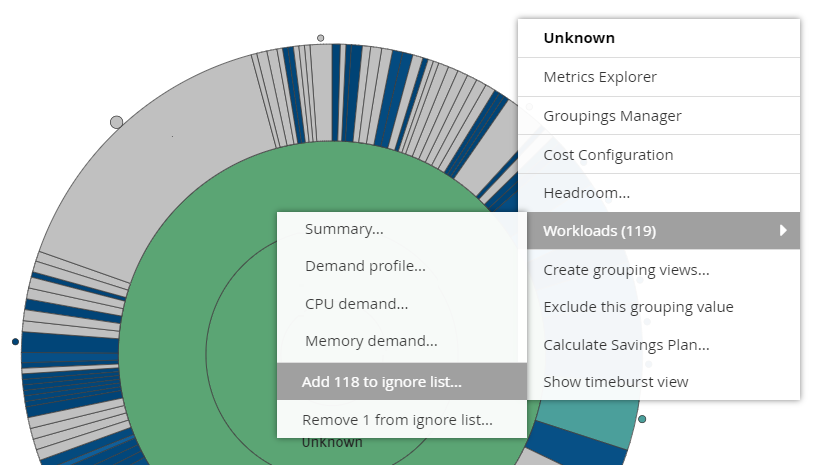
To remove machines from the ignore list:
- Open all ignored instances in the Default recommendation tab.
- Select the ones you wish to remove.
- Click Remove selected from ignore list.
Note that when you add or remove instances from the ignore list, needs to recalculate Saving Plans. In the Saving Plans tab, click the refresh button to recalculate.
Reservations Copied
When making its recommendations, Capacity Planner takes into account the Reservations (Reserved Instances for AWS and Reservation Groups for Azure) that you have already purchased to ensure that they are delivering value.
In the Reservations tab of the Recommend panel you can check the following:
- The recommendations and savings for the existing Reservations and Reserved Instances (RI) groups.
- The recommendations of Reservations and Reserved Instances (RI) groups you can purchase to make additional savings.
- You can also view the summary of all reservations combined.
Note that this documentation explains how Reservations are used and analysed in Capacity Planner. For more information on how Reservations work and how their specifications are applied, please refer to AWS documentation
Reservations optimisation Copied
Reserved Instances (RI) and Reservations groups combine Reserved Instances and Reservations whose specifications overlap. In the Existing RI groups table, you can see the details of those groups:
- What region, family, and operating system they belong to.
- A recommendation of how many Reserved Instances or Reservations to buy and how much you can save following this recommendation.
- The optimisation chart indicates how optimised your Reserved Instances or Reservations are.
- The detailed recommendations and timeseries for the group (to see these, click more).
The optimisation chart Copied
The optimisation chart indicates how optimised your reserved instances are. For each Reservation group, there is an indicator of how far from the optimal number of reservations that particular group of reservations is (calculated based on the last 3 months of activity):
-
The arrows indicate where you currently are with your reservation plan.
-
The indicators (vertical lines) point to the following:
- The first indicator — there are no reservations.
- The second indicator (the longest vertical line) — the optimal size of your reservation bucket (100% capacity).
- The third indicator — your reservation bucket is twice too big (you have too many reservations).
- The fourth indicator — your reservation bucket is three times too big (you have too many reservations).
This image shows an example of different optimisation recommendations for the reservation groups:
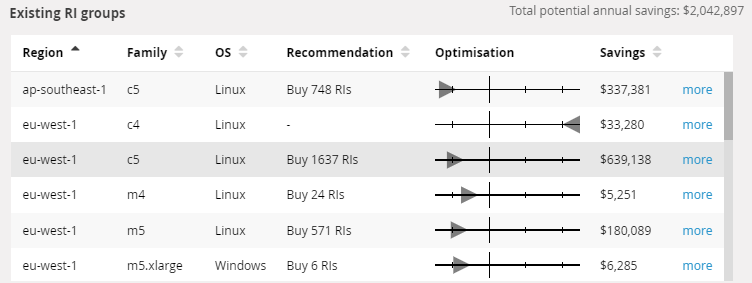
To see detailed timeseries of instance count and recommendations for each reservation group, click more:

This chart provides you with the following information:
- Normalization factor (NU) of the instance size of the instances that belong to this RI group. Note that Reserved Instances (RI) groups combine Reserved Instances whose specifications overlap. For more information, see AWS documentation
.
- Specification of the Reserved Instances (such as cost or region).
- Blue line — indicates your current capacity which is the size of the Reserved Instances plan that you currently have.
- Green line — indicates the usage of the Reserved Instances plan that you currently have. You can see the activity of the machine types that match the normalization factor (NU).
- Hover the mouse over any point in the timeseries to see the number of instance types active at that point in time.
- Orange line — based on the analysis of the usage, this is where your Reserved Instances bucket should be.
Reservations summary Copied
You can also see the overview of all the Reservations that you purchased (Reserved Instances for AWS and Reservation Groups for Azure ). To do that, click more next to the View all reservations combined summary:

- The lines indicate the activity of your Reservations.
- If the line is going down, it means the reservations expire at this point of time.
- If it is going up, this indicates that reservations were purchased at this point of time.
- The blue line always shows all of your reservations.
- The orange line only shows the selected reservations (if no reservations are selected, this will be the same as the blue line).
- To select the reservations that belong to a specific category, click that specific category. For example, if you click a specific region, all instances belonging to that region will be selected. Note that the selection will remain the same as you move through all pages of the summary.
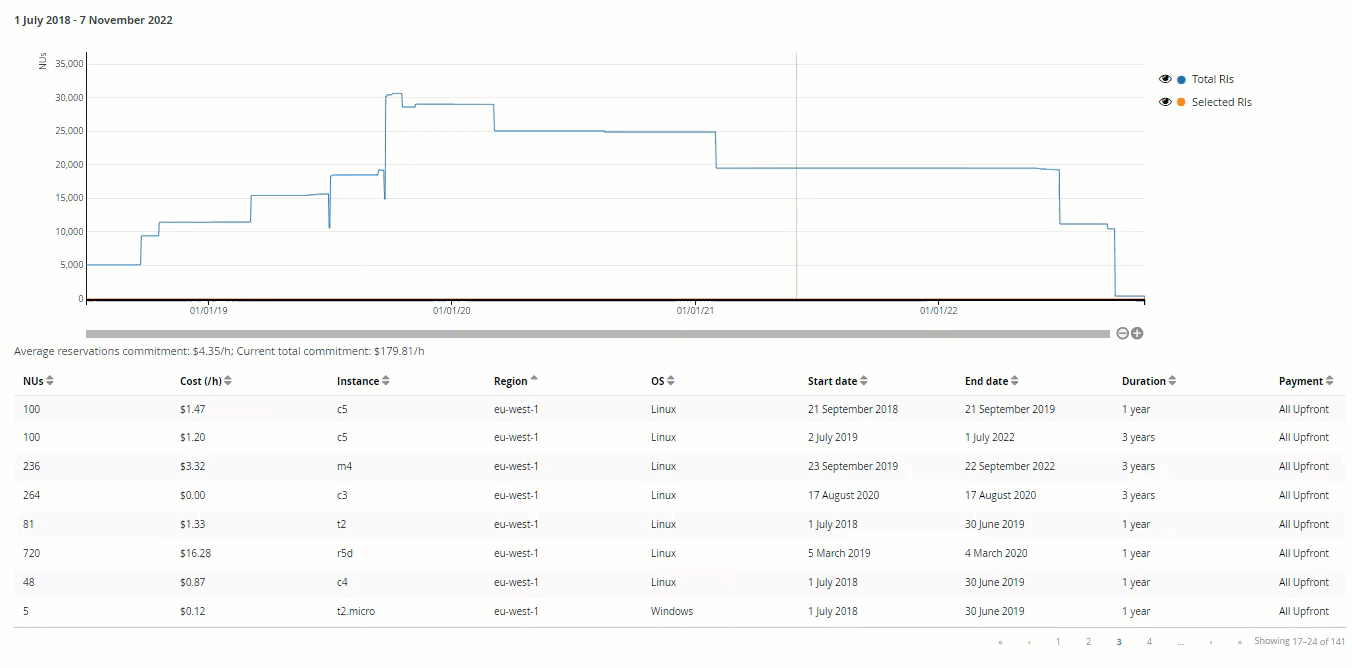
Recommendations for non-cloud environments Copied
This section describes the features available in the Recommend panel if you are using a non-cloud environment. If you are using AWS or Azure, see Recommendations for cloud environments.

Server activity and storage recommendations Copied
In the Default Recommendations tab, you can find the server activity and storage recommendations for machines that are idle, underprovisioned, and overprovisioned. When you change the sunburst view, recommendations are dynamically updated to display information relevant to your current view.
To see the full list of recommendations, click more. This displays the list of all machines with detailed recommendation on how to adjust the following:
- CPU and memory for servers.
- Demand and free space for storage.
To filter your view further, you can use the Grouping columns to provide more information about the machines. For more information on how to use groupings, see Groupings manager Groupings manager.
All recommendations are based on configured activity and right-sizing rules. For more information, see Configure recommendations.
Configure recommendations Copied
To configure activity and right-sizing rules for the recommendations, click ![]() in the Default Recommendations tab, and select one of the options:
in the Default Recommendations tab, and select one of the options:
Note: Recommendations are only based on machines that are currently active. If a machine is switched off, it is not taken into consideration in the recommendations.
Configure activity rules Copied
You can configure activity thresholds to fit an appropriate recommendation. Server activity is defined by the activity grouping. For more information, see Activity grouping.
When you change your configuration, the recommendations are automatically updated. Any machine or instance exceeding your configured activity thresholds can be assigned the following recommendations:
- Idle — machines or instances that meet these criteria are listed as idle and are recommended to be switched off.
- Low — machines or instances that meet these criteria are listed as overprovisioned and are recommended to be right-sized.
- High — machines or instances that meet these criteria are listed as underprovisioned and are recommended to be right-sized.
- All other machines or instances are considered normal.
You can restore these settings at any point by clicking Reset.
In the example below, machines or instances that are considered as idle fall within the following criteria:
- CPU 95th percentile is less than 5, and
- IO is less than 20 MB/s, and
- Memory 99th percentile is less than 10.

Configure right-sizing rules Copied
You can set rules based on which right-sizing will be recommended. The configuration is the same as for the right-sizing operations. For more information on available measures, see Select measures in Right-sizing.
To see how recommendations change once you modify the right-sizing rules, click more next to the machines that have right-sizing recommendations.
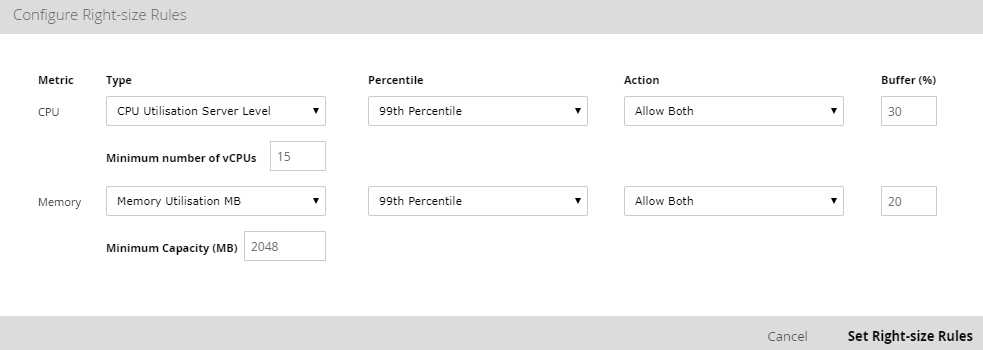
Cloud migration Copied
In the Cloud migration tab, you can check the estimated cost of migrating your virtual machines into one of the cloud providers. Currently, Amazon Web Services (AWS) and Azure are available.
Capacity Planner looks at all the active machines that are currently visible in your sunburst view and determines the closest and most cost-effective match for each virtual machine. It automatically suggests cloud instance configurations in AWS and Azure , scoped to a baseline view, taking optimal capacity configuration into consideration in order to reduce costs effectively. The pricing details and available configuration are pulled directly from the cloud provider using API so they are always up to date.
The following migration options are available:
- Like for like — estimated costs of migration if you do not follow the right-sizing recommendations.
- Rightsized — estimated costs of migration if right-sizing recommendations are followed.
Depending on your use case, you can change the recommendation rules. To do this, click ![]() for the required cloud provider and select one of the configuration options:
for the required cloud provider and select one of the configuration options:
-
Configure AWS / Azure migration rules
- You can select settings such as region, instance family that the cloud provider provides, or network performance. For example, if you only select EU regions as your location, Capacity Planner will look for optimum configuration in those regions only.
- You can exclude idle machines from your recommendation rules. This means that idle machines will not be moved to cloud. These machines will show as Unmatched in your migration recommendation.
-
Configure right-sizing rules — for more information on available measures, see Select measures in Right-sizing.
Click more next to the migration option to see a list of all VMs and the recommended instance type for that particular machine and its price. You can then export the recommendation to a CSV file.
- To filter your view further, you can use the Grouping columns. For more information on how to use groupings, see Groupings manager.
- To see detailed recommendations for a specific instance, click Options
 next to the instance that you wish to see details of, and select Recommendations. For more information, see Instance options.
next to the instance that you wish to see details of, and select Recommendations. For more information, see Instance options.
You can add or remove segments to change what your baseline is showing. This dynamically updates the recommendations. In this way, you can model your potential AWS or Azure environment in Capacity Planner.
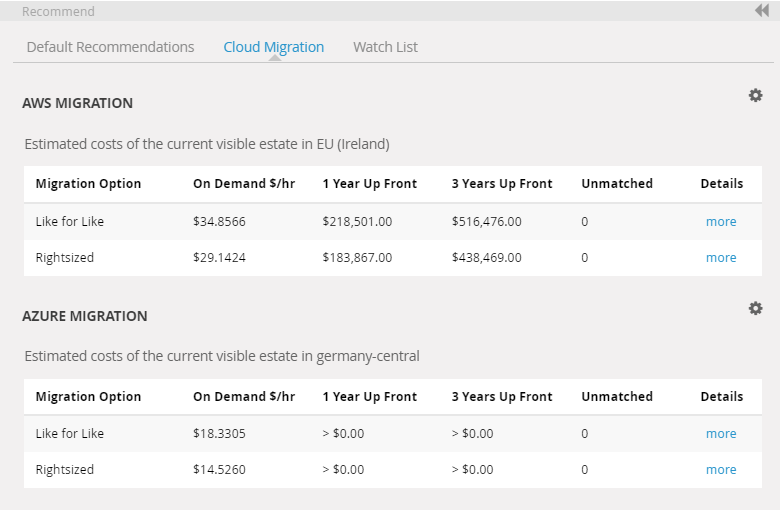
Watch list Copied
The Watch list tab displays entities where metric measures are currently breaching thresholds.